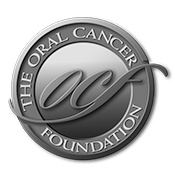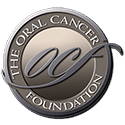A personal battle sets the stage for public change.
by Ginny Blossom, The Los Angeles Times
Cancer survivor… As I waited for Brian Hill to show up for our interview, I mentally thought about what I was expecting, lots of facts about the disease, the goal of the new Oral Cancer Foundation he was establishing, and of course I reminded myself not to stare, since I knew that many people who had survived this disease, lived with facial disfigurements from the surgery. Imagine my surprise when a normal looking man in his fifties walked into my office and introduced himself as Brian. Dressed in blue jeans and a T-shirt that said “Rugby – elegant violence” on the front of it, with a close cropped goatee, this wasn’t the entrepreneur-turned-activist that I had expected.
Right away he started in, not about oral cancer, but about how a convergence of seemingly unrelated events focuses peoples lives to a particular task. Famous athletes, aviators, activists, inventors. Names that we all know, but who came to a particular course in their lives as a result of seemingly unconnected events and circumstance, mated with the recognition of an opportunity. Hold that thought… he’s off on another line. “Why do so many people die from oral cancer? Why don’t we hear more about it?” First, the statistics come out. “30,000 (2021 edit. Since this interview, the number has changed in 2021 to 54,250) people will be diagnosed with it this year, in 5 years only 50% of them will still be alive, that’s more deaths than from cervical cancer, Hodgkin’s disease, skin cancer, and many others. My story both illustrates the issue, and the problem.” I settle in, listening. I don’t think that I’m going to have to ask too many questions in this interview.
He begins his story as a 19-year-old enlisted man in Vietnam with the First Medical Battalion, First Marine Division, in the late 60’s. While he doesn’t care to go into the details of his time in Vietnam on what he calls “one of Uncle Sam’s guided tours of Southeast Asia “, it is clear from our discussion that this is where he developed his interest in medicine, and a few core values that have stayed with him over the years. Not having the grades or the money to get into a medical or dental school when he returned from the war, he started out as a sales and technical rep for several big medical firms. Over the years he worked his way up through the management ranks in sales, marketing, and advertising, at companies like American Hospital Supply and Bristol Myers, finally working for several smaller firms who specialized in facial and dental implants. In 1987, having obtained a “real world degree, under the mentorship of some of the finest managers in the industry”, he started his own company, Implant Support Systems Inc. which designed, manufactured, and sold dental implants world wide. Flash forward to 1993 when his company was being sold to Lifecore Biomedical, a publicly traded firm who specializes in synthetic body fluids and implantable devices. He jokes that this was the “American dream incarnate”, “a kid with a high school education, works his way through the system, ends up as a visible, well known lecturer who has spoken at major universities and implant symposiums around the world, who builds a multi-million dollar firm from his spare bedroom, and sells it for millions of dollars while still young enough to enjoy it all.” While he says this all in an off-hand and casual way, it is clear that this is a person who has both a passion and a plan for things that he takes on.
” I was on top of the world, living in two homes, one in the resort area of Lake Tahoe, and in a turn of the century adobe in Santa Fe, New Mexico, enjoying the fruits of what we had built. Ingrid (his wife) and I spent our days skiing, hiking, climbing, flying our aerobatic plane, traveling around the world… life really couldn’t have been any better. Well, maybe not having to shovel that 400 inches of snow off of my driveway which fell the first year we lived at the lake would have made it better……….” The American dream indeed.
But then one day everything changed. Hidden under his full beard that had grown in since giving up his suit and tie, a lump appeared on the side of his neck. “I felt great in all respects, and except for this painless hard spot in my neck, I was completely without other symptoms.” He decided to visit an ear, nose, and throat specialist to have it checked out. The conclusion was that it was likely just a swollen lymph node from perhaps a tooth abscess, or some other infection. He was put on antibiotics for a week to clear things up. “I knew that my dental health was in order, after all, working in the industry, I was very dentally aware.” More than that, he had seen two different dentists in the last 12 months, one for a check up and x-rays, the other to have a crown done on a lower molar. Two different hygienists had also taken care of his regular 6-month cleanings. “I thought to myself, I couldn’t have any dental problems causing this, my dentists were on top of my oral health, and I took great care of my mouth”. When the antibiotics had no effect, a second ENT was consulted, and took a look at things. “He noticed a red patch in the back of my throat right next to my tonsil, and it was decided that a fine needle biopsy would be done of the swollen node”. A couple of days later the news that changed everything in his world came in the laboratory report. It was malignant. That red patch was a squamous cell carcinoma, which had developed on the pillar of his right tonsil, and had been there long enough to metastasize to his neck, as it turned out on both sides. “When I looked in my mouth at the doctors office with a hand mirror, there it was, as plain as day. A large red discoloration the size of a dime. It didn’t hurt. How long had it been there?” “To get to that size and start to spread to your neck, probably 18 to 30 months,” the doctor said. “Well, I’ve had people looking and working in my mouth during that period…………why didn’t they see this thing?” “The question just hung in the air, and the ENT shrugged his shoulders.”
“After I picked myself up off the floor, the questions started running through my head. I mean, the words cancer and death are used in the same sentence too often for my liking.” Brian immediately started calling friends in the medical community, and all recommendations were for him to go to M.D. Anderson Cancer Center in Houston, Texas. Consistently rated as the premier head and neck cancer institution in the world, it seemed like the right choice. “Ingrid and I rented a small apartment next to the hospital and tried to get settled in for the long process ahead of both of us.” “When I first checked into MD Anderson, I was scared. I knew that having this cancer caught fairly late in its development, a stage 4, wasn’t good. But the facility and the caliber of people I came in contact with helped settle my mind. With a staff of over 25,000, and a facility which covers acres, they treat over 250,000 cancer patients who arrive from around the world every year. It seemed if someone was going to save my life, this would be the place it could happen. It was like walking into NASA. The latest technologies coupled with the finest staff. I started believing that I could come out of this OK.”
MDACC repeated the tests and MRI’s that were previously done to confirm the extent of the disease, and a treatment plan was developed which included both radiation treatments and surgery. ” I felt a part of the entire process, and that helped me deal with what was going to happen. The loss of control when you are ill with something like this can be tough, especially when you are a driven, make it happen, take charge kind of personality. I mean, after you have chosen the care providers, you are completely putting yourself in someone else’s hands to effect your cure. This is when the revelation that any control you think you have in your life is actually an illusion started to form in my mind. I was definitely not in control of things anymore.” About this time Brian started learning more about his cancer, for instance that it appeared 75% of the time in people who use tobacco, but he had never smoked. There was no family history of cancers. He ate right, was physically active, and exercised. The only risk factor that seemed to fit, was that he was in the right age group.
“I started thinking about two valuable lessons that I had learned in Vietnam. The first is that life is finite. Our culture doesn’t talk much about death as a part of our lives, and we have a tendency to think we are going to go on forever. War makes you acutely aware that is not the case. Even in daily life, you never know when that truck with your name on the bumper is going to come around the corner. It’s a perspective that keeps you focused on optimizing each day, and all your experiences. The second lesson was that you can do everything right, and still die. You can wear your helmet and flack jacket, keep your head down etc., and still be killed. It happens every day, over there, or here and now. I had lived a healthy life, and had none of the risk factors for this particular cancer. There was nothing I could have changed in my lifestyle to prevent it. But this cancer was positioning itself to end my life. I had forgotten these two realities during the 25 years after the war. Or perhaps I just lost the keenness of that perspective. In my new war with cancer, they both came back into crisp focus.”
Weeks of daily radiation treatments began to blister and burn the skin on the outside of his neck; it became openly raw, and had to be covered with a burn salve all the time. The inside of his mouth and throat were the same, constantly bleeding, and full of open sores from the radiation. “The pain and discomfort of the radiation burns were indescribable. Painkillers became a daily necessity, and I no longer could eat or drink through my mouth. I was throwing up all the time. A feeding tube was inserted directly into my stomach through my chest. That was how I would eat and take my medications for the balance of a year”. Even after the radiation treatments ended, there was still the surgery to remove the lymph tissues from the right side of his neck. “After the surgery, I thought to myself, finally it’s done, the worst is over.” But that’s when the radiation sickness took hold in full force. Months of it. “By this stage of things I had lost about 50 pounds of body mass. I had become so weak that I couldn’t even open the pop-top on a can of liquid food that I poured into my tube and feeding bag. Then the mental depression set in. The fight in me left, and between the pain, the treatments, the emotional upheaval, the narcotics, the constant nausea, and weakness, all of it became overwhelming, and I really wanted to give up.” He jokes that at first he was afraid he was going to die, but at this stage he was afraid he wasn’t going to die. He says with a laugh, that the idea of putting his head in the oven to end it all seemed attractive, until he remembered that it was electric. He sees that I don’t find the humor in his comments. “Gallows humor, it’s part of the coping process,” he concedes.
Months passed and slowly he began to get his strength back. Then there was the issue of getting off of the addictive painkillers that he had been taking for the better part of a year. The withdrawal was a brand new battle. Other complications arose. His immune system, beaten up by the therapies, allowed infections to take a hold in his mouth and elsewhere. “It seemed like it was just one thing after another. I can honestly say that I would have never made it through this alone. Ingrid was with me every treatment, every step of the way. She became more than my wife, she was my nurse, cleaned up after me when I was vomiting all the time, fed me, and was my whipping boy when life became unbearable. Through it all, she never wavered, never complained, and never gave up. When I wasn’t strong enough to get through it, she became my strength. Long time friends rallied with daily emails and phone calls, though my throat was so raw that I couldn’t speak the answers to their questions. They were determined to keep my mind positive, and remind me that they, and a life were waiting for me out there. Ingrid brought home a T-shirt for me one day. On the back of it was printed, It’s not the size of the dog in the fight, it’s the size of the fight in the dog. It couldn’t have been more appropriate. The doctors had done their part, and my wife and friends were doing theirs. This part of the battle was squarely on my shoulders.”
The friends were right. Slowly over a couple of years, Brian’s life has normalized. There are some visible signs of the battle, a scar that runs around his neck, which is now missing a portion of its right side, and a water bottle, always in his hand to compensate for the extreme dry mouth (xerostomia) that was a result of the destruction of his salivary glands by the radiation. “I can’t swallow without a drink of water, and dry foods are out of the question, but considering the alternative, it’s a small price to pay for being on this side of the grass,” he says. And there are the few silver linings that he finds humor in. ” I used to really love wines. We vacationed in Napa, collected favorite vintages, and traveled to wine festivals around the country. Up until a couple of months ago, drinking wine was out of the question. It was like drinking kerosene, and when I attempted to try some, it would burn my throat unbelievably”. And there was the issue of taste itself, “radiation took a toll on my taste buds, and things didn’t taste the same anymore, if they tasted like anything at all.” Recently, he said excitedly, that has changed. ” I drank my first glass of wine the other day, and it tasted great! But since not all of my ability to taste has returned, I couldn’t tell that it was so bad, my wife said it should have been put on the salad instead of in our wine glasses! Just think of it. I’ll now be happy drinking $5.00 bottles of wine!” The other silver lining has to do with shaving. “I always hated to shave. The radiation, which covered an area from just behind my chin to just behind my ear on each side, destroyed all the hair follicles in its path. So now I have a nice goatee, which just happens to be in style these days, and I don’t have to shave at all!”
While Brian doesn’t like to dwell on it, he knows that there is still a danger of a re occurrence. “Oral cancer is notorious for producing second, primary tumors, particularly in the first 5 years after treatment. Armed with what I know now, I’ll be looking for any signs of it, and it won’t go unnoticed like the first time.” Which brings us to the new Oral Cancer Foundation. “Most of the progress which has been made in the survival rates of all cancers has been through early detection. While there has been progress in lowering some of the death rates, we have not made great strides in treatment, which those of us that have been through it jokingly call the slash, burn, and poison approach. Oral cancer should not hold the high position it does as a killer. When it is caught early, it is 80 to 90% curable. It is one of the few cancers that does not require a special test, an invasive procedure, or special equipment to discover it. Literally, it is right under your nose, and not only early cancer, but even the tissue changes which precede it, can be seen with the naked eye, or felt with the fingers. There is no good reason that it should lie undetected if anyone is looking for it. That is what the foundation is all about. Letting the public know the facts. Building their awareness of the disease and the need for an annual screening. Everyone should ask their dentist, every year, to do a thorough screening, especially if they are over 40 years old, and particularly if they have been a smoker. Screenings take less than 5 minutes, are not uncomfortable, and are often free or inexpensive. A dental exam, when it incorporates a cancer screening, can save your life.” The foundation’s work will also involve pushing for more aggressive participation by dental professionals, and efforts in tobacco cessation, particularly with young people. I can see that Brian’s attitude has changed during our conversation. While there was an eagerness to tell me his story, what I sense in his tone now is more intense, more passionate. He is clearly on a mission.
And all that discussion at the beginning of the interview about the convergence of circumstances? Here is Brian’s take on it all. “The issue is not about new treatments or technology, it is about awareness and opportunities for screening. Changing public and professional awareness is essentially a marketing issue, something I have been involved in for over 25 years. And the people most likely to have a major impact on the death rate from oral cancer? The dental community, by doing an annual screening, just like others that have become commonplace in our lives, like pap smears or mammograms. I have worked in the dental industry for 30 years, and I have a good sense about what it will take to bring the issue to the forefront of that industry. What about perspective? Well, I’ve been through the disease treatment process and survived. I understand the issues and problems first hand, from not having it caught during my dental exams, to dealing with the treatments and recovery. And time? I’ve made my mark in the business world and enjoy the financial rewards of that. I have the time in my life to take up this cause and challenge. Lastly, timing. The public is ready to change things. They want to know the facts about issues that impact their lives. They are more interested and involved in their own health than at any time in history. Reducing the death rate from this disease is tangible, palpable, and doable in the immediate future. All in all, I would say that I am uniquely qualified to take up this cause and challenge at this particular moment in time. It’s almost as if my whole life was building the experiences necessary to go out and do this.” Then with a laugh he says, “With my bad boy youth, and a life centered around getting myself ahead, who would have thought that I would end up the poster boy for a cause like this? It just somehow feels right inside…………….”
I don’t know if Brian is an unlikely champion, but my instincts tell me he and the foundation are going to make a difference. To learn more about the foundation, to become involved as a professional or public member, or to inquire about speakers for an event, you can reach the Oral Cancer Foundation Message Center at (949) 723-4400, or contact Brian Hill at his direct line (949) 278-4362.
Addendum. This interview from the LA Times is now more than 2 decades old. While the story is the same, some of the disease facts represented in this article are clearly now out of date. This interview was given before HPV16 was firmly established as a risk factor, and percentages and numbers related to the disease mentioned in it have changed many times in the past decades. Please use the main body of the OCF web site to obtain the most current data and not this article.)
Brian Hill editorial directed at the dental community – Dental Abstracts Magazine, 2003




